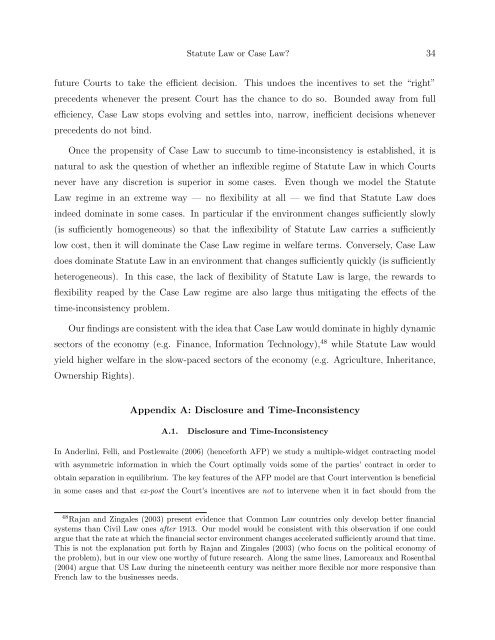Case Law, Statutory Law, Municipal Ordinances & Policy
Case Law, Statutory Law, Municipal Ordinances & Policy
Case Law, Statutory Law, Municipal Ordinances & Policy
You also want an ePaper? Increase the reach of your titles
YUMPU automatically turns print PDFs into web optimized ePapers that Google loves.
Statute <strong>Law</strong> or <strong>Case</strong> <strong>Law</strong>? 34<br />
future Courts to take the efficient decision. This undoes the incentives to set the “right”<br />
precedents whenever the present Court has the chance to do so. Bounded away from full<br />
efficiency, <strong>Case</strong> <strong>Law</strong> stops evolving and settles into, narrow, inefficient decisions whenever<br />
precedents do not bind.<br />
Once the propensity of <strong>Case</strong> <strong>Law</strong> to succumb to time-inconsistency is established, it is<br />
natural to ask the question of whether an inflexible regime of Statute <strong>Law</strong> in which Courts<br />
never have any discretion is superior in some cases. Even though we model the Statute<br />
<strong>Law</strong> regime in an extreme way — no flexibility at all — we find that Statute <strong>Law</strong> does<br />
indeed dominate in some cases. In particular if the environment changes sufficiently slowly<br />
(is sufficiently homogeneous) so that the inflexibility of Statute <strong>Law</strong> carries a sufficiently<br />
low cost, then it will dominate the <strong>Case</strong> <strong>Law</strong> regime in welfare terms. Conversely, <strong>Case</strong> <strong>Law</strong><br />
does dominate Statute <strong>Law</strong> in an environment that changes sufficiently quickly (is sufficiently<br />
heterogeneous). In this case, the lack of flexibility of Statute <strong>Law</strong> is large, the rewards to<br />
flexibility reaped by the <strong>Case</strong> <strong>Law</strong> regime are also large thus mitigating the effects of the<br />
time-inconsistency problem.<br />
Our findings are consistent with the idea that <strong>Case</strong> <strong>Law</strong> would dominate in highly dynamic<br />
sectors of the economy (e.g. Finance, Information Technology), 48 while Statute <strong>Law</strong> would<br />
yield higher welfare in the slow-paced sectors of the economy (e.g. Agriculture, Inheritance,<br />
Ownership Rights).<br />
Appendix A: Disclosure and Time-Inconsistency<br />
A.1.<br />
Disclosure and Time-Inconsistency<br />
In Anderlini, Felli, and Postlewaite (2006) (henceforth AFP) we study a multiple-widget contracting model<br />
with asymmetric information in which the Court optimally voids some of the parties’ contract in order to<br />
obtain separation in equilibrium. The key features of the AFP model are that Court intervention is beneficial<br />
in some cases and that ex-post the Court’s incentives are not to intervene when it in fact should from the<br />
48 Rajan and Zingales (2003) present evidence that Common <strong>Law</strong> countries only develop better financial<br />
systems than Civil <strong>Law</strong> ones after 1913. Our model would be consistent with this observation if one could<br />
argue that the rate at which the financial sector environment changes accelerated sufficiently around that time.<br />
This is not the explanation put forth by Rajan and Zingales (2003) (who focus on the political economy of<br />
the problem), but in our view one worthy of future research. Along the same lines, Lamoreaux and Rosenthal<br />
(2004) argue that US <strong>Law</strong> during the nineteenth century was neither more flexible nor more responsive than<br />
French law to the businesses needs.

















